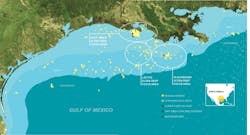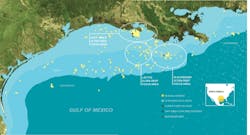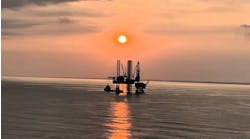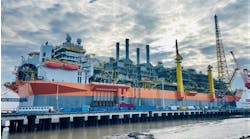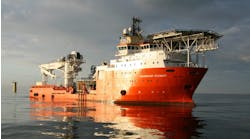Bruce Beaubouef • Houston
BP updates spill containment
BP has provided an update on developments in the response to the MC252 oil well incident in the Gulf of Mexico.
At press time, two containment systems continue to collect oil and gas flowing from theDeepwater Horizon’s failed BOP and transport them to vessels on the surface. The lower marine riser package (LMRP) containment cap, installed on June 3, is taking oil and gas to the Discoverer Enterprise where oil is collected and gas flared. The second system, which began operations on June 16, takes oil and gas to the Q4000 vessel on the surface where both oil and gas are flared.
On July 3, a total of approximately 25,198 bbl of oil were collected or flared by the two systems and 57.0 MMcf of gas were flared. Specifically, the LMRP containment system connected to theDiscoverer Enterprise collected 17,022 barrels of oil, and the Q4000 flared an additional 8,176 bbl of oil. To date, the total volume of oil collected or flared by the containment systems is approximately 585,400 bbl.
Preparations continue for the next step in containment operations. Work on the first floating riser containment system planned to be connected to theHelix Producer was delayed by heightened sea states caused by Hurricane Alex as it passed through the Gulf of Mexico. The floating riser system is designed to allow more rapid disconnection and reconnection of the system, reducing the time that collection may be impacted in the case of inclement weather. It was expected that this first floating riser system would be available to begin operations by the end of the first week of July. Plans also are being developed for additional containment capacity and flexibility. These projects are currently anticipated to begin operations around mid-late July.
BP notes that the LMRP containment cap system, theQ4000 system, and the planned additional containment systems have not been deployed at these depths or under these conditions before, and their efficiency and ability to contain or flare the oil and gas cannot be assured.
Work on the first relief well, which started May 2, continues. The well reached a depth of 17,725 ft (5,403 m) on July 4 and a sixth “ranging” run was completed. The second relief well, which started May 16, had reached a measured depth of 13,871 ft (4,228 m) as of press time. Both wells are still estimated to take approximately three months to complete from commencement of drilling.
Work continues to collect and disperse oil that has reached the surface of the sea, to protect the shoreline, and to collect and clean up any oil that has reached shore. Approximately 44,500 personnel, more than 6,563 vessels, and some 113 aircraft are now engaged in the response effort.
For continuous news, videos, and analysis on the incident, visit: offshore-mag.com/index/deepwater-horizon-oil-spill-2010.html.
McMoRan issues activity report
McMoRan Exploration Co. has issued an update on its shallow-water Gulf of Mexico exploration activities, including indications of potential hydrocarbon-bearing zones at the Blueberry Hill deep gas sidetrack and in-progress drilling at the Davy Jones and Blackbeard East ultra-deep prospects.
The Blueberry Hill No. 9 STK1, on Louisiana State Lease 340 in 10 ft (3 m) of water, commenced drilling on April 26, 2010, and has been drilled to a TVD of 23,500 ft (MD 24,279 ft). Logging-while-drilling has indicated sands with high resistivity levels below 23,100 ft (7,041 m), which may be the beginning of a hydrocarbon-bearing interval.
McMoRan Exploration Co. is advancing its exploration activities in the shallow-water Gulf of Mexico.
McMoRan says it is setting a drilling liner above the identified sand section before evaluating the No. 9 STK1 well with wireline logs to determine the porosity of the identified sands and quantify potential net pay in the well. Because the current depth of the well is in a resistive sand, additional drilling is required to determine the thickness of the identified sand interval. The Blueberry Hill No. 9 STK1 has a proposed TVD of 24,000 ft (7,315 m).
The company also reports that drilling is under way on the Davy Jones offset appraisal well on South Marsh Island block 234, 2.5 mi (4 km) southwest of the discovery well, which logged 200 net feet of pay in multiple Eocene/Paleocene (Wilcox) sands below 27,300 ft (8,321 m) in January 2010. The offset appraisal well is currently drilling below 10,800 ft (3,292 m) towards a proposed TD of 29,950 ft (9,129 m), and is expected to test similar sections up-dip to the discovery well, as well as deeper objectives, including potential additional Wilcox and possibly Cretaceous (Tuscaloosa) sections. Davy Jones involves a large ultra-deep structure encompassing four OCS lease blocks (20,000 acres).
The Blackbeard East ultra-deep exploration well spudded on March 8, 2010, and currently is drilling below 17,700 ft (5,395 m). The well, in 80 ft (24 m) of water on South Timbalier block 144, has a proposed TD of 29,950 ft (9,129 m) and will target Middle and Deep Miocene objectives seen below 30,000 ft (9,144 m) in Blackbeard West, nine miles away, as well as younger Miocene objectives.
Offshore Articles Archives
View Oil and Gas Articles on PennEnergy.com
